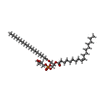+Search query
-Structure paper
| Title | Structural basis for gating the high-conductance Ca-activated K channel. |
|---|---|
| Journal, issue, pages | Nature, Vol. 541, Issue 7635, Page 52-57, Year 2017 |
| Publish date | Jan 5, 2017 |
 Authors Authors | Richard K Hite / Xiao Tao / Roderick MacKinnon /  |
| PubMed Abstract | The precise control of an ion channel gate by environmental stimuli is crucial for the fulfilment of its biological role. The gate in Slo1 K channels is regulated by two separate stimuli, ...The precise control of an ion channel gate by environmental stimuli is crucial for the fulfilment of its biological role. The gate in Slo1 K channels is regulated by two separate stimuli, intracellular Ca concentration and membrane voltage. Slo1 is thus central to understanding the relationship between intracellular Ca and membrane excitability. Here we present the Slo1 structure from Aplysia californica in the absence of Ca and compare it with the Ca-bound channel. We show that Ca binding at two unique binding sites per subunit stabilizes an expanded conformation of the Ca sensor gating ring. These conformational changes are propagated from the gating ring to the pore through covalent linkers and through protein interfaces formed between the gating ring and the voltage sensors. The gating ring and the voltage sensors are directly connected through these interfaces, which allow membrane voltage to regulate gating of the pore by influencing the Ca sensors. |
 External links External links |  Nature / Nature /  PubMed:27974801 / PubMed:27974801 /  PubMed Central PubMed Central |
| Methods | EM (single particle) |
| Resolution | 3.8 Å |
| Structure data | |
| Chemicals |  ChemComp-PGW: |
| Source |
|
 Keywords Keywords | MEMBRANE PROTEIN / ion channel / K+ channel / Ca2+ bound / high conductance |
 Movie
Movie Controller
Controller Structure viewers
Structure viewers About Yorodumi Papers
About Yorodumi Papers






